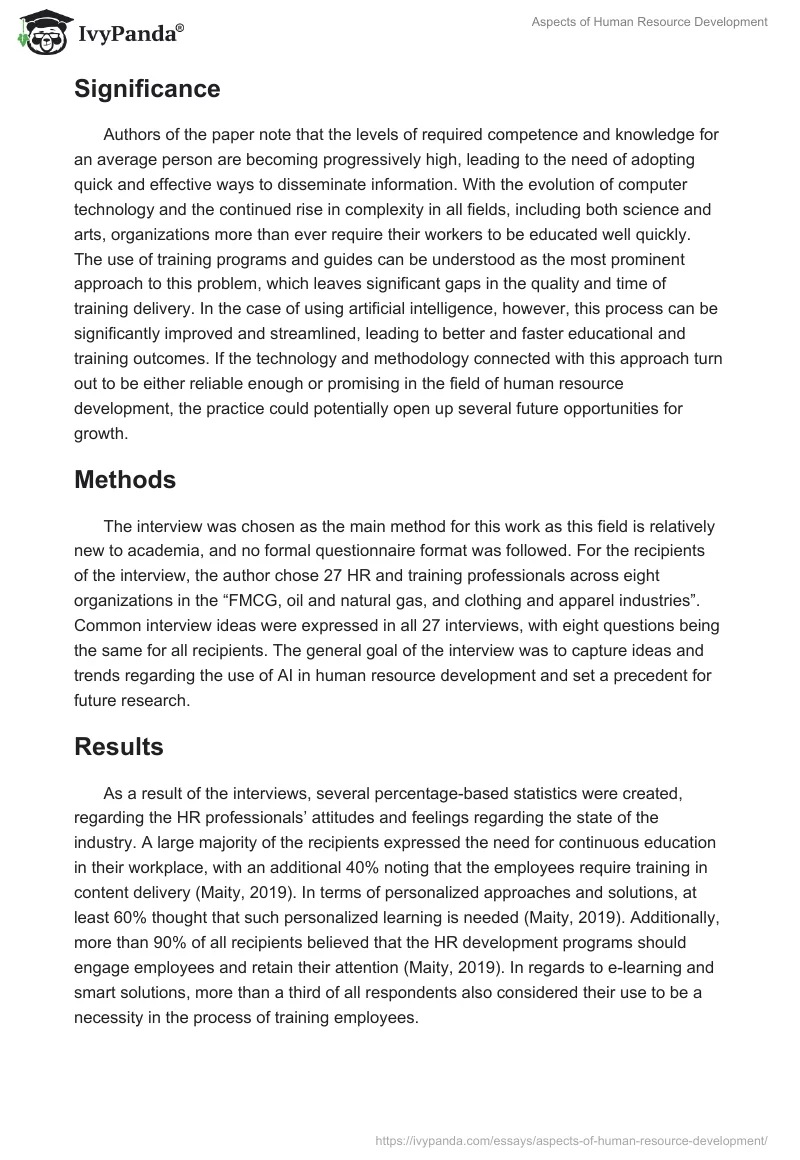Introduction
Human resource development is a field that has constantly and continuously been improved, both with the introduction of better workplace practices and the evolution of employment theories. The production and facilitation of workplace excellence have always been a goal of managers and leaders, who have an increased incentive in working with an educated and trained worker base. The creation of this field and its growth have been documented and demonstrated in research papers and other works of significance. In the present review, a particular paper regarding Human Resource Development will be examined, as a way to understand both the present state of the industry and acquire some current-day insights into its latest practices. The review will discuss the goals, methods, significance, and results of a study named “Identifying opportunities for artificial intelligence in the evolution of training and development practices”.
Article Analysis
Summary
As mentioned in the article, the fast pace of modern industry makes it necessary for workers to be continuously educated and trained in a variety of high-competence skills. In this effort, the use and adoption of mass-produced training methods become ineffective, leaving room for personalized approaches and singular solutions. The use of artificial intelligence, then, is said to hold a lot of potential in the work of educating employees. In particular, training and development programs designed with employee engagement and involvement in mind are speculated to be a great way to support the field. As the current precedent for such technology is small, the paper discusses and theorizes on the feasibility of this method, and its potential uses in the future.
Significance
Authors of the paper note that the levels of required competence and knowledge for an average person are becoming progressively high, leading to the need of adopting quick and effective ways to disseminate information. With the evolution of computer technology and the continued rise in complexity in all fields, including both science and arts, organizations more than ever require their workers to be educated well quickly. The use of training programs and guides can be understood as the most prominent approach to this problem, which leaves significant gaps in the quality and time of training delivery. In the case of using artificial intelligence, however, this process can be significantly improved and streamlined, leading to better and faster educational and training outcomes. If the technology and methodology connected with this approach turn out to be either reliable enough or promising in the field of human resource development, the practice could potentially open up several future opportunities for growth.
Methods
The interview was chosen as the main method for this work as this field is relatively new to academia, and no formal questionnaire format was followed. For the recipients of the interview, the author chose 27 HR and training professionals across eight organizations in the “FMCG, oil and natural gas, and clothing and apparel industries”. Common interview ideas were expressed in all 27 interviews, with eight questions being the same for all recipients. The general goal of the interview was to capture ideas and trends regarding the use of AI in human resource development and set a precedent for future research.
Results
As a result of the interviews, several percentage-based statistics were created, regarding the HR professionals’ attitudes and feelings regarding the state of the industry. A large majority of the recipients expressed the need for continuous education in their workplace, with an additional 40% noting that the employees require training in content delivery (Maity, 2019). In terms of personalized approaches and solutions, at least 60% thought that such personalized learning is needed (Maity, 2019). Additionally, more than 90% of all recipients believed that the HR development programs should engage employees and retain their attention (Maity, 2019). In regards to e-learning and smart solutions, more than a third of all respondents also considered their use to be a necessity in the process of training employees.
Discussion
It can be said that the paper in question has explored an interesting and needed field for future study. The author makes a good case for the avenue of using artificial intelligence and e-learning as a way to better employee education. However, it should also be noted that there are significant limitations to this paper, especially regarding the methodology and sample size. Due to the limited coverage, this topic has currently received, there are no reliable frameworks for conducting research, which left Maity with using an interview method with no fixed list of questions or particular structures to work off of. In addition, only 27 professionals were interviewed, which is a statistically small number that can not be indicative of industry opinion as a whole. Despite these setbacks, the paper presents a good starting point for future relevant discussions and analysis.
Conclusion
In conclusion, it should be said that “Identifying opportunities for artificial intelligence in the evolution of training and development practices” is an ambitious and interesting paper to discuss, one that offers an outlook on the facet of Human Resource Development that does not receive enough attention. While exploring and expanding upon the existing methods for promoting worker excellence can be effective, the use and adoption of new technology into the process hold much promise.
Reference
Maity, S. (2019). Identifying opportunities for artificial intelligence in the evolution of training and development practices. Journal of Management Development. Web.


